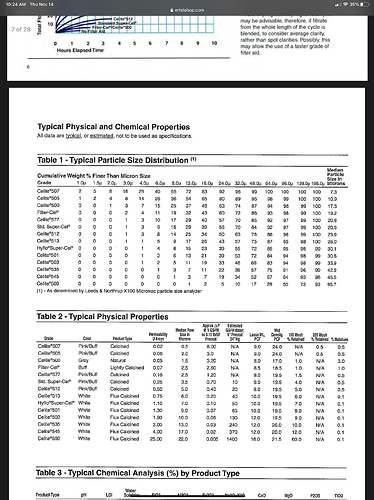Can anyone tell me what micron you would consider a celite cake to be? Maybe a 1” thick cake, if that matters?
Anyone?
Its supposed to be a catch all. I would NOT rely on just the celite. I consider 1 micron to be a must after the 5 mic plate. just my personal standards. lots of redundancy. low mic. essentially assume there is no celite …
I’m not, I use paper. I’m just wondering if you could quantity the level of filtration you get from a celite cake into microns.
A 1" bed will filter ac fines on top of a fritted disc buchner funnel.
That’s literally exactly what I’m doing and using. Lol.
I have 500ml, 600ml, 1000ml fritted disc buchner funnels. I always do a 2" celite 545 cake. I do not get any fines from my trim washes.
I pull vac at -26.5 on the dial with a welch 2252 diaphram vacuum pump. Could be +/-
So I’m truly just wondering if you can associate a micron number to what you get from running through a celite cake. Purely for my own curiosity
How fine are ac fines? That may be another avenue to ask about. Since the Celite stoped them all when I cleaned up some nasty green etoh.
I actually tried to find any kind of reference for this, and all I could find was the particle size of celite, which is 17-25 microns.
You got me curious as well, but I came up empty handed.
I mean nothing gets by the celite cake. 17-25 microns makes sense for the particle size but once wet packed into a filter that cake is super denser. I had a hard time even formulating this question.
Yeah, if I remember correct, it’s from the structure of it, it kind of locks together and acts like a lattice?
I did have to re-read your op, at first I was like, I know fickle knows particle size. Then I reread the question and understood what your asking.
Lmao. Thanks bro!
I think you asked a question that cannot be easily answered!!
I’m digging through all the datasheets I can find and not finding anything regarding this info, it’s killing me lol.
Now that I can’t find the answer, of course I have to know.
I’ve been digging as well and just can’t find anything. Maybe we need one of the many people who is way smarter than myself on here for some input??
Agreed, this one is over my head fer sure. That’s not saying a whole lot though!
Were in the same boat for sure. Lol
I’m pretty sure it’s the structure that makes it effective for holding back carbon. The porosity of the particles in DE or celite trap particles that can typically pass a paper filter. The catch is you should wash the stuff over a sintered plate so that the smaller particles come through. Then add your filter stack and run your crc as it is more for catching rogue celite but also acts as a catch all for any mediums that can bypass the celite (which is pre wet /rinsed should be basically nada)
So if celite can catch what a paper filter can not, what micron would you consider it to be? That’s really what I’m after
